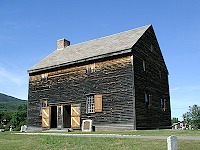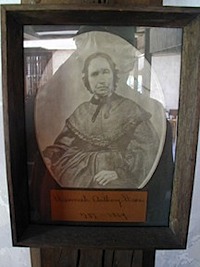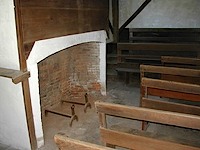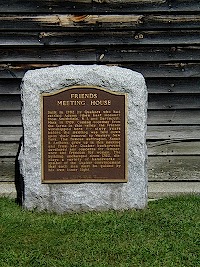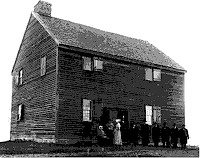The East Hoosuck Quaker Meeting House
Maple Street Cemetery, Adams, Massachusetts
This old building, so closely associated with the settlement of the town of Adams, reflects in its sturdy construction and simplicity the character of its builders.
The present town of Adams was settled soon after 1769, by a group of Quakers, most of them from Smithfield, Rhode Island, and the nearby town of Dartmouth, Massachusetts. They were neighbors and friends of the settlers in nearby New Providence, on Stafford Hill (Cheshire), who were staunch Baptists. The Friends soon settled and owned nearly all the farms in this valley. They worshipped for a time in their homes, usually that of Isaac Killey. In 1782 they erected this building, and it was used continuously by them for over sixty years. In their transaction of business, the men and women held separate meetings and kept separate records. For this reason the Meeting House was constructed in the manner we see, with the two outer doors, and movable partitions to provide privacy during separate meetings. The building has remained in it's original unrestored condition.
In the religious service the partitions were raised. The women sat on the left side, where they received the benefit of the fireplace. On the elevated seats were seated visiting preachers, or leaders. Hannah Hoxie, a talented preacher, occupied the high seat on the women's side for many years. Since there were no evening meetings, there was no provision for lighting the building. If there were two Sunday services those driving from a distance brought their lunch and stayed to both services.
A brief sketch of the pioneers of Adams and the meeting house where they worshiped
as published in 1992 by the Adams Historical Commission
The Quaker Meeting House is the most important historical landmark in Adams. It is a memorial to the pioneer people who first settled the tract of land that became Adams. The Quakers, or Friends as they called themselves, were a religious denomination who came from the Smithfield, Rhode Island area. They were the first group of settlers to form a community in East Hoosuck, the original name of the Adams township.
"There is that of God in every person."
Quaker precepts were based on the belief that each person is guided by their own inner light. The Friends went so far as to believe that one did not need a church or clergy to bring them closer to God, the guiding inner light was all that was necessary. The Friends refused to maintain an established minister. As a result of their unconventional beliefs they were persecuted and even hung on Boston Common in the 1660s.
Their Sabbath day services were spent keeping the "appointed hour of silence," a time when they gathered together and sat in silence listening to whatever might come from the silence. A Friend expressed the idea of silence in this way:
"We come together from many corners of life - let us sit down in reverent silence. Let us each put down our burdens and help one another to rest. Let us become listening souls, for it will not be in earthquake, or fire but in a still small voice, that He will make His presence known. It will be in unhurried stillness that we shall be conscious of His voice."
They lived in Adams for 15 years before starting to build the meeting house in 1782. They finished it four years later. It took so long to complete because the Friends were less interested in a monumental place of worship than living their lives according to their religious precepts.
The Quakers most likely moved to the Hoosac Valley in the 1760s because the area was recently opened for development. The Quakers must have felt the spirit of adventure that compelled so many Americans to leave the comforts of their homes to pioneer the wilderness to the west.
"Quakerism is a way of life."
In order to focus on this presence of God. the Friends simplified their external. everyday life and removed any obstacle they thought might hinder their contact with that inner presence. Consequently, the Quakers did not smoke, drink "spiritous liquors" or dance. They followed a code of severe simplicity or "plainness" that was reflected in their fashion, furnishings, speech and architecture.
Examples of their sober clothing can be seen in the old photograph to the right - bonnets and shawls for women; long, dark coats and wide brim hats for men.
The meeting house, like many Quaker homes, was built with very little ornamentation and left unpainted.
Their "plain speech" replaced the days of the week and months of the year with numbers. Sunday became "first day" and June became "sixth month."
Church was, of course, a "meeting house" and religious services were called "meetings." the name of their religious sect was simple and to the point, "Society of Friends." The name was simple in comparison to the names of most denominations: Episcopalian, Presbyterian, Greek Orthodox, etc.
Plainness followed them into the after life as the Quakers did not mark their graves with headstones. The open area in front of the meeting house is the resting place of many pioneer Quakers.
"Simple faith flows over into a wide field of human conduct."
The Friends had a strong sense of social justice. They opposed slavery, war and capital punishment; befriended the Indians; and sought the humane treatment of prisoners and the mentally ill. They were one of the first groups in the world to educate women and recognized a degree of equality of the sexes not permitted by the rest of society at that time.
In Adams, the Quakers harboured runaway slaves from New York state which did not abolish slavery until 1826 (Massachusetts abolished slavery in 1790). Several of the runaways settled in Adams and lived out the rest of their lives here.
Although it was the Quakers' belief to oppose war, there were some members of the East Hoosuck Friends Meeting who served in the Battle of Bennington, our area's participation in the Revolutionary War. A plaque on a boulder near the meeting house memorializes those who "laying aside their religious scruples took up arms in defense of their homes and liberties."
The highway past the Meeting House was originally an Indian trail, the Pontoosuck Path, so called, which connected with Mohawk Trail in the north part of the valley. It is now appropriately called Friend Street. One of the early settlers on this road was David Anthony, whose family was destined to occupy a prominent place in the town and whose great-granddaughter, Susan B. Anthony, became a national and worldwide figure.
This Meeting House is under the care of the Adams Society of Friends Descendants, but is owned by the town, which also cares for the burial ground in front of the Meeting House, where the pioneer Friends rest in their unknown and unmarked graves.
The cemetery was used by the Friends for a considerable period before the Meeting House was built, and not until 1797 was the land formally deeded by Isaac Killey, John and Patience Lapham and John Russell and James Lapham, to David Lapham and John Wells who held it for a brief period before turning it over to the Society of Friends.
The Friends were keenly interested in the education of their children, and erected schools at an early period.
They have left a tradition of an honest, upright and right-living people, whose impress on the town's life will long endure.
